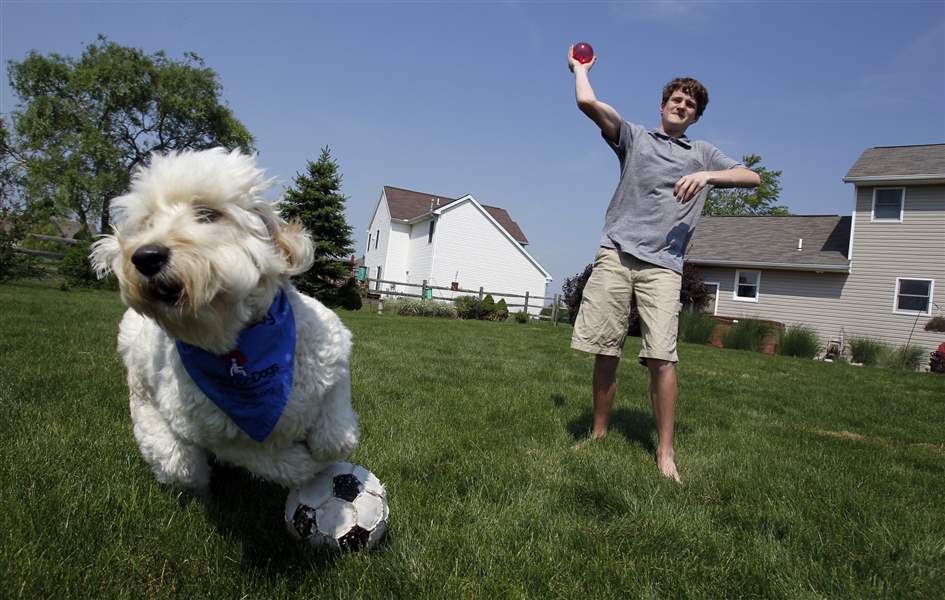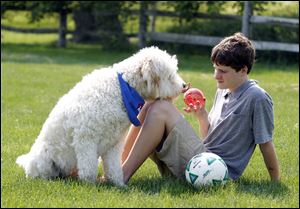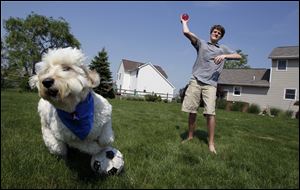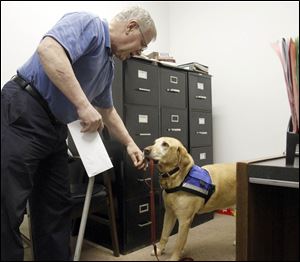
A friend in need: Dogs help owners who have disabilities
7/24/2011
Matthew Perretti, 14, plays with his dog Tango at his home.
The Blade/Andy Morrison
Buy This Image

Therapy dog Tango has helped Matthew Perretti, 14, who has Asperger's syndrome, become more comfortable interacting with people.
Whoever said dogs are man’s best friend got it only partly correct.
Dogs are not only man’s, and woman’s, best buddies but they also seem to be miracle workers in their ability to soothe our anxieties and calm us when we are upset. They have special insight, as they often seem to know when something is wrong.
And they are social experts because they pull the reserved outside of themselves, a role that is becoming increasingly common for therapy dogs.
That’s why Jill and Mike Perretti acquired a therapy dog for their son Matthew, 14, a ninth grader at Anthony Wayne High School this fall, who has Asperger’s syndrome, a high-functioning form of autism.
"I wanted to give him something that would make him responsible for something outside of himself," said Ms. Perretti, Matthew’s mother.
Matthew, who has a 3-year-old male golden doodle named Tango, communicates with animals better than people. And Tango, of course, accepts the teenager unconditionally.
"That’s why we went with a therapy dog," she said.
Matthew got his first therapy dog when he was about 7. Onyx, a black Labrador, has since died, but having her was a rewarding experience for the Perrettis, and Matthew asked for another one.

Matthew Perretti, 14, plays with his dog Tango at his home.
"We didn’t realize at the time the impact Onyx had on being able to calm him down," Ms. Perretti said. "The dog was a source of him thinking outside himself. We didn’t need to remind him to feed or brush the dog."
Tango doesn’t go to school with Matthew. He does not have public access rights. But Matthew talks about Tango.
"We found that he was approaching and interacting with people without having to be prompted," Ms. Perretti said.
She knows about dogs from a different angle. As client services coordinator for Assistance Dogs of America, Inc., in Swanton, she said therapy dogs are trained alongside of service dogs. The Perretti family began fostering dogs several years ago.
Cedar, an 8-year-old yellow Lab, goes to work with his boss, Gary Phipps of Swanton. The chemist for Scottdell, Inc., which makes carpet cushions, has had multiple sclerosis for 17 years and uses a scooter.
Cedar opens doors, gets the telephone, retrieves items Mr. Phipps drops, and puts his feet in the bed for him. "She’s been a complete game-changer for me," he said.
The bond he has developed with the dog in five years helps him to focus on his job.
"I don’t have time to focus on why I can’t walk, but she keeps me going every day. As a dog, she’s the best friend you could ever want."
Jenny Barlos, client services director for Assistance Dogs of America in Swanton, concurs.
"Assistance dogs not only provide a specific service to their handlers, but also greatly enhance their lives with a new sense of freedom and independence," she said.
There are three types of assistance dogs: guide dogs for the blind and visually impaired, hearing dogs for the deaf and hard of hearing, and service dogs for people with other disabilities.
Training of dogs to assist the physically or mentally disabled is a recent concept, Ms. Barlos said. In most countries, disabled individuals can take assistance dogs anywhere into the public where they are guaranteed legal access.

Cedar, Gary Phipps' assistance dog, gives hims his leash while his owner works in his office at Scottdel Inc.
ADAI’s staff consists of only six full-time and eight part-time employees. That’s why it relies on a large network of foster families to train dogs for periods that range from several days up to two years. Most of the dogs — from 8 to 10 weeks old, coming from breeders, shelters, and rescue groups — are Labrador and Golden retrievers or mixes of those breeds, standard poodles, labradoodles, and golden doodles.
Circle Tail, Inc., in Pleasant Plain, Ohio, is a nonprofit organization that trains service and hearing dogs, adopts dogs to the public, and trains dogs to respond to people after they have had seizures. Depending on the severity of the seizure, these dogs respond by pulling a life-line switch in the home, lying down next to their owner, or getting a telephone, pillow, or another family member in the house.
Although some people believe that dogs can be trained to alert people to oncoming seizures, Marlys Staley, the executive director of Circle Tail, Inc., is doubtful. It’s more likely, she said, that a dog has learned to recognize warning signs — such as behavior or body scent — in owners who have frequent seizures. The dogs then try to make their owners aware that something is about to happen by pawing or nudging them, or not obeying commands.
"And then 10 minutes later they have a seizure," Ms. Staley said. "Some dogs are that in tune to their person. The tricky part is that the person has to cue in to the dog’s alerting behavior."
Foster families as well as inmates at correctional facilities help to train ADAI dogs. Circle Tail also has dogs in the Ohio Reformatory for Women at Marysville, and at the London and the Ross correctional facilities.
At the Toledo Correctional Facility in North Toledo, prisoners who are accepted into the program are instructed by ADAI’s prison puppy coordinator to train dogs that are between 1 and 2 years old. The dogs live with inmates in cells for up to a year. To ensure that dogs are socialized, for one week out of every month those dogs are removed from the prison to live with a family.
The program gives inmates skills and requires them to behave to stay in the program.
"Even more important than that, for many of these guys, it’s their way of giving back to society," Ms. Barlos said. "In many cases, it’s the first success that they have had and in some cases, it’s the first love that they have had without someone asking for something in return."
The cost of assistance dogs can reach $18,000 when veterinarian, food, and staff expenses are totaled, but Ms. Barlos pointed out that "If someone can be helped by a dog, we don’t want cost to be a prohibiting factor."
Assistance Dogs of America works with people to find funding. The agency, which gets no state or federal money, charges a $50 application fee and an equipment fee that starts at $300. Dog owners are not required to fund-raise; the agency hosts special events to raise money, she added.
Though some dogs don’t make it into the program, their training is not in vain. The Swanton agency has a waiting list of people who want to adopt those dogs.
Many have heard about dogs acting strangely around their owners, some who later learned that they have cancer and their pet tried to bring it to their attention. While research into that area is being conducted, Ms. Staley said it’s just a matter of training dogs to recognize various odors.
"Whether it’s drugs, cancer, bed bugs, it’s all just teaching them ‘this is the smell I want you to find,’" she said. "It seems impressive, but it’s really not rocket science."
Contact Rose Russell at: rrussell@theblade.com or 419-724-6178.